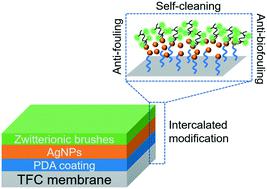当前位置:
X-MOL 学术
›
Environ. Sci.: Water Res. Technol.
›
论文详情
Our official English website, www.x-mol.net, welcomes your feedback! (Note: you will need to create a separate account there.)
Enhancing the anti-fouling and fouling removal properties of thin-film composite membranes through an intercalated functionalization method
Environmental Science: Water Research & Technology ( IF 5 ) Pub Date : 2021-5-26 , DOI: 10.1039/d1ew00188d Caihong Liu 1 , Andreia F. Faria 2 , Jennifer Jackson 2 , Qiang He 1 , Jun Ma 3
Environmental Science: Water Research & Technology ( IF 5 ) Pub Date : 2021-5-26 , DOI: 10.1039/d1ew00188d Caihong Liu 1 , Andreia F. Faria 2 , Jennifer Jackson 2 , Qiang He 1 , Jun Ma 3
Affiliation

|
In this study, we propose an intercalated surface modification strategy that combines three important functionalities in thin-film composite (TFC) membranes: 1) resistance to the deposition of organic fouling, 2) anti-biofouling properties in static and cross-flow conditions, and 3) an improved self-cleaning property that reflects the membranes' ability to easily release attached bacteria cells. The membrane functionalization strategy consists of immobilizing a polydopamine (PDA) layer, followed by the intercalation of silver nanoparticles (AgNPs) and poly (sulfobetaine methacrylate) (PSBMA) zwitterionic brushes (PDA–Ag–PSBMA TFC). The presence of zwitterionic PSBMA brushes shields the membrane surface against the non-specific adsorption of fluorescent bovine serum albumin (BSA), demonstrating a superior anti-fouling property. Moreover, the PSBMA brushes impart the TFC membranes with an excellent ability to release attached cells under gentle agitation. AgNPs intercalated between PDA and PSBMA layers, on the other hand, enabled a prolonged anti-biofouling property by efficiently inactivating ∼90% of the attached Pseudomonas aeruginosa cells. Dynamic biofouling experiments under a cross-flow condition and confocal laser scanning microscopy (CLSM) imaging show reduced flux decline and inhibition of biofilm formation for PDA–Ag–PSBMA TFC membranes, respectively, confirming the effectiveness of our intercalated surface modification strategy for simultaneous control of organic fouling and biofouling.
中文翻译:

通过插层功能化方法提高薄膜复合膜的防污除垢性能
在这项研究中,我们提出了一种插层表面改性策略,该策略结合了薄膜复合 (TFC) 膜中的三个重要功能:1) 抵抗有机污垢的沉积,2) 在静态和错流条件下的抗生物污垢特性, 3) 改进的自清洁性能,反映了膜轻松释放附着细菌细胞的能力。膜功能化策略包括固定聚多巴胺(PDA)层,然后插入银纳米粒子(AgNPs)和聚(磺基甜菜碱甲基丙烯酸酯)(PSBMA)两性离子刷(PDA-Ag-PSBMA TFC)。两性离子 PSBMA 刷子的存在保护膜表面免受荧光牛血清白蛋白 (BSA) 的非特异性吸附,显示出优异的防污性能。而且,PSBMA 刷子赋予 TFC 膜在温和搅拌下释放附着细胞的出色能力。另一方面,插入 PDA 和 PSBMA 层之间的 AgNPs 通过有效地灭活约 90% 的附着物,实现了延长的抗生物污垢性能。铜绿假单胞菌细胞。交叉流条件下的动态生物污染实验和共聚焦激光扫描显微镜 (CLSM) 成像分别显示 PDA-Ag-PSBMA TFC 膜的通量下降减少和生物膜形成抑制,证实了我们的插入式表面改性策略对同时控制的有效性有机污垢和生物污垢。
更新日期:2021-06-08
中文翻译:

通过插层功能化方法提高薄膜复合膜的防污除垢性能
在这项研究中,我们提出了一种插层表面改性策略,该策略结合了薄膜复合 (TFC) 膜中的三个重要功能:1) 抵抗有机污垢的沉积,2) 在静态和错流条件下的抗生物污垢特性, 3) 改进的自清洁性能,反映了膜轻松释放附着细菌细胞的能力。膜功能化策略包括固定聚多巴胺(PDA)层,然后插入银纳米粒子(AgNPs)和聚(磺基甜菜碱甲基丙烯酸酯)(PSBMA)两性离子刷(PDA-Ag-PSBMA TFC)。两性离子 PSBMA 刷子的存在保护膜表面免受荧光牛血清白蛋白 (BSA) 的非特异性吸附,显示出优异的防污性能。而且,PSBMA 刷子赋予 TFC 膜在温和搅拌下释放附着细胞的出色能力。另一方面,插入 PDA 和 PSBMA 层之间的 AgNPs 通过有效地灭活约 90% 的附着物,实现了延长的抗生物污垢性能。铜绿假单胞菌细胞。交叉流条件下的动态生物污染实验和共聚焦激光扫描显微镜 (CLSM) 成像分别显示 PDA-Ag-PSBMA TFC 膜的通量下降减少和生物膜形成抑制,证实了我们的插入式表面改性策略对同时控制的有效性有机污垢和生物污垢。


























 京公网安备 11010802027423号
京公网安备 11010802027423号